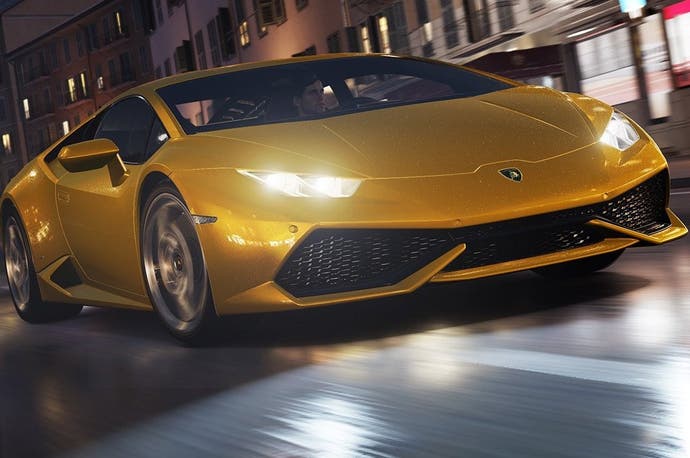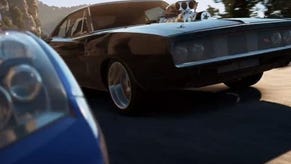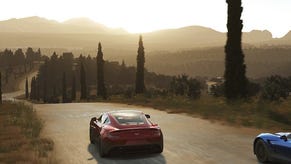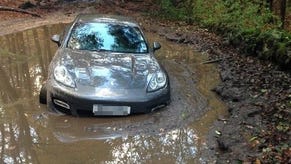Face-Off: Forza Horizon 2
The end of the road for Xbox 360?
Now this is the last-gen conversion - or HD demaster, if you like - that we wanted to see. Forza Horizon 2 on Xbox One is a highlight of the new console era: a phenomenal package of state-of-the-art rendering technology, open-world gameplay and a brilliant driving simulation melded into an outstanding arcade-style racer. Could this remarkable achievement really translate across to the vintage 2005 Xbox 360 hardware?
When pre-release video eventually emerged on YouTube last week, initial impressions looked positive - against all odds, UK-based Sumo Digital appeared to have handed in a phenomenally close conversion. But could the Xbox 360 version stand up to Digital Foundry scrutiny? Loading up the Xbox 360 code and replicating that initial road trip to the Horizon festival in the Lamborghini Huracan shows Sumo Digital's work at its best - the initial blast through the coastal town of Castelletto reveals clear compromise, but the spirit of the experience is uncannily similar to the Xbox One title.
Pulling up at the festival tent and choosing your first car via two different takes on the car selection screen, we also see that the high-end vehicle modelling utilised by each version of the game is also very close to like-for-like. However, once the Forza Horizon festival begins proper, parity becomes a thing of the past: Playground Games goes one way on Xbox One, while Sumo Digital veers off in its own radically different direction on Xbox 360. What we have here are two versions that share assets, environments, concepts and themes - but in execution each release is to all intents and purposes a completely different game, and that's actually a very good thing.
Sumo Digital hasn't gone out to slavishly trace out the Xbox One blueprint. Certainly in terms of overall technology, that would have been a fool's errand - in pure technical terms, the 360 version cannot hope to compete. The beautiful physically based rendering of Playground Games' version is gone, replaced with a plainer, more flat representation of in-game lighting. Similarly, the remarkable simulation of varying weather conditions has not made its way across to Xbox 360 - weather in the last-gen world is uniformly sunny up against varying conditions on Xbox One from bright skies to lashing storms, incorporating often stunning atmospheric rendering. The gradual shift of the time of day is included, however, but time-lapse comparisons in like-for-like spots demonstrate that Xbox One is a world apart from its last-gen counterpart.
Microsoft's new console has over 10 times the available RAM of the old 360, and it shows. To its credit, Sumo has recreated the same open world in much more constrained conditions - to the point where like-for-like GPS queries produce identical routing cross-platform - but the overall detail level is significantly pared back. There are far more repeating textures and incidental detail takes the heaviest hit of all. The off-roading driving options of the Xbox One version remain, but it's very often a more barren experience on 360.
The general sense of discovery in the open world remains, but the feeling of danger when driving on the edge isn't quite so pronounced. Uniform weather conditions is a factor here, but it's also the case that there's far less traffic on the road on the last-gen version, making the task of moving from point A to point B easier on a more general level. Driving the same car on the same road also feels different too - it might be the different pads, of course, but we get the idea that the Forza driving simulation model has moved onto the next level on Xbox One, while remaining rooted in the past on Xbox 360. It's an observation that perhaps sums up the game in general - Playground Games and Turn 10 evolved Forza for the new wave of hardware, but Horizon 2 on Xbox 360 is firmly based on established technology [UPDATE 5/10/14 10:26am: And that means 720p resolution with MSAA anti-aliasing, though it's difficult to discern whether the additional FXAA pass found in the original Forza Horizon is retained.]
Shorn of its show-stopping next-gen features, there's a very real danger that Forza Horizon 2 on Xbox 360 could have been a profound disappointment - a forlorn shadow of the original that ticks all the relevant boxes, but lacks purpose, relevance and soul, rather like the PS3 and Xbox 360 versions of Watch Dogs. However, when code arrived, we sat down to play - and hours later we were still there, even though it quickly became evident that the structure of the game was very, very different to the Xbox One flagship. And arguably, that's what makes Forza Horizon 2 on 360 worth checking out if you've yet to upgrade to a new console.
Once the initial car selection is complete, the Horizon festival road trip begins - and the journey through the game is almost entirely different to the Xbox One experience. There is commonality in the structure of the game world and the cars you'll drive through it, but the differences between the two games stack up very quickly. Events and circuits in each location are entirely unique to each version, while supplementary 'side quests' - such as the bucket list tests that see you take a new car on loan for a single challenge - are also different from one game to the next. Even the showcase events, where your car takes on various alternative land- and air-based vehicles, are also shaken up with unique content.
The overall impression is that Sumo hasn't exactly ported Forza Horizon 2 from Xbox One to the 360, but rather that it has produced its own companion piece that is better suited to the hardware limitations of the older console. There's also the sense that it has sought to extract the best possible results from the existing Xbox 360 engine created for the original Horizon, as opposed to tackling the nigh-on impossible task of scaling down the Xbox One codebase. Generally speaking, the approach works, even though one of the most satisfying experiences of the new game feels a little lacking on Xbox 360.
Off-road racing is a core component of Forza Horizon 2, and on Xbox One, the sensation of ploughing cross-country, blasting through detail-rich, thick foliage is one experience that feels new and exciting, helping to give the game the feeling that the title is a true next-gen pioneer in the racing genre. There's nothing to stop you driving off-road on Xbox 360, but the events structure to make the most of it is lacking - you leave the tarmac in many events, but the emphasis remains on circuit racing.
Other next-gen elements are also missing in the Xbox 360 game - specifically, the vast range of online gameplay features Playground has shoehorned into the Xbox One title. There's also no Drivatar AI either - much maligned by many in Forza Motorsport 5, comparing Forza Horizon 2 between Xbox 360 and Xbox One demonstrates how worthwhile the feature actually is - if only for the unpredictability the evolved AIs add.
You can ratchet up difficulty in Horizon 2 on 360, but you never quite shake the sense that you're battling an algorithm - the human mind detects patterns, forges strategies to beat them and eventually prevails. On Xbox One, there is the sense that Playground has refined the Drivatar formula - the dangerous ineptitude often witnessed in Forza Motorsport 5 doesn't seem to be as much of an issue now, and while you're still battling an algorithm, there is the sense that a human element of sorts has been added that adds spice to the gameplay. It's also interesting to note that there is a correlation between the real-life user and the effectiveness of the driver AI - when a Drivatar based on a real-life racing game developer makes an appearance in our game, the challenge level gears up significantly.
We went into this article looking to produce a Face-Off similar to the Titanfall on Xbox 360 analysis. Based on those initial YouTube vids, we thought it would be great to compare the two version of Forza Horizon 2 with the same degree of like-for-like scrutiny that we employed back then, and with Sumo Digital on coding duties we had high hopes for the result. As it happens, that simply wasn't possible - and the story is arguably more interesting as a result.
Forza Horizon 2 represents something of a full-stop for the franchise on the Xbox 360. Sumo took on the excellent Playground/Turn 10 codebase but there's the feeling that it couldn't push the level of technical achievement further, resulting in a revised game design that made the most of the technologies and assets available, in the final analysis producing a very different game to the Xbox One showcase. It's a fine title worthy of the hardware it is running on and the pedigree of the studios involved - but it is perhaps more of a sideways step than a full-blown sequel. That game does exist, however - and it is spectacular - but it does remain exclusive to Xbox One.



















